8 Issues in Health and Human Services Management: Depression Report
VerifiedAdded on 2021/10/30
|9
|2066
|64
Report
AI Summary
This report delves into the multifaceted issue of depression within the context of Health and Human Services Management (HHSM). It begins by defining depression, outlining its scope, common symptoms, and the need for resources, including organizations, financial support, and treatment options. The report then explores various strategies for addressing depression, with a particular emphasis on Cognitive Behavioral Therapy (CBT) and the use of antidepressant medications. It further examines several management theories, including Behaviorism, Cognitive Theory, and Psychodynamic Theory, analyzing their applicability and limitations in the context of depression. The report provides insights into the implementation of management theories, especially the cognitive approach, to identify and correct negative thought patterns. Finally, the report offers different perspectives on depression, including Behaviorist, Psychodynamic, and Cognitive Behavioral perspectives, and concludes by summarizing the key findings and recommendations for effective depression management. This report provides a comprehensive overview of depression management in the field of health and human services.
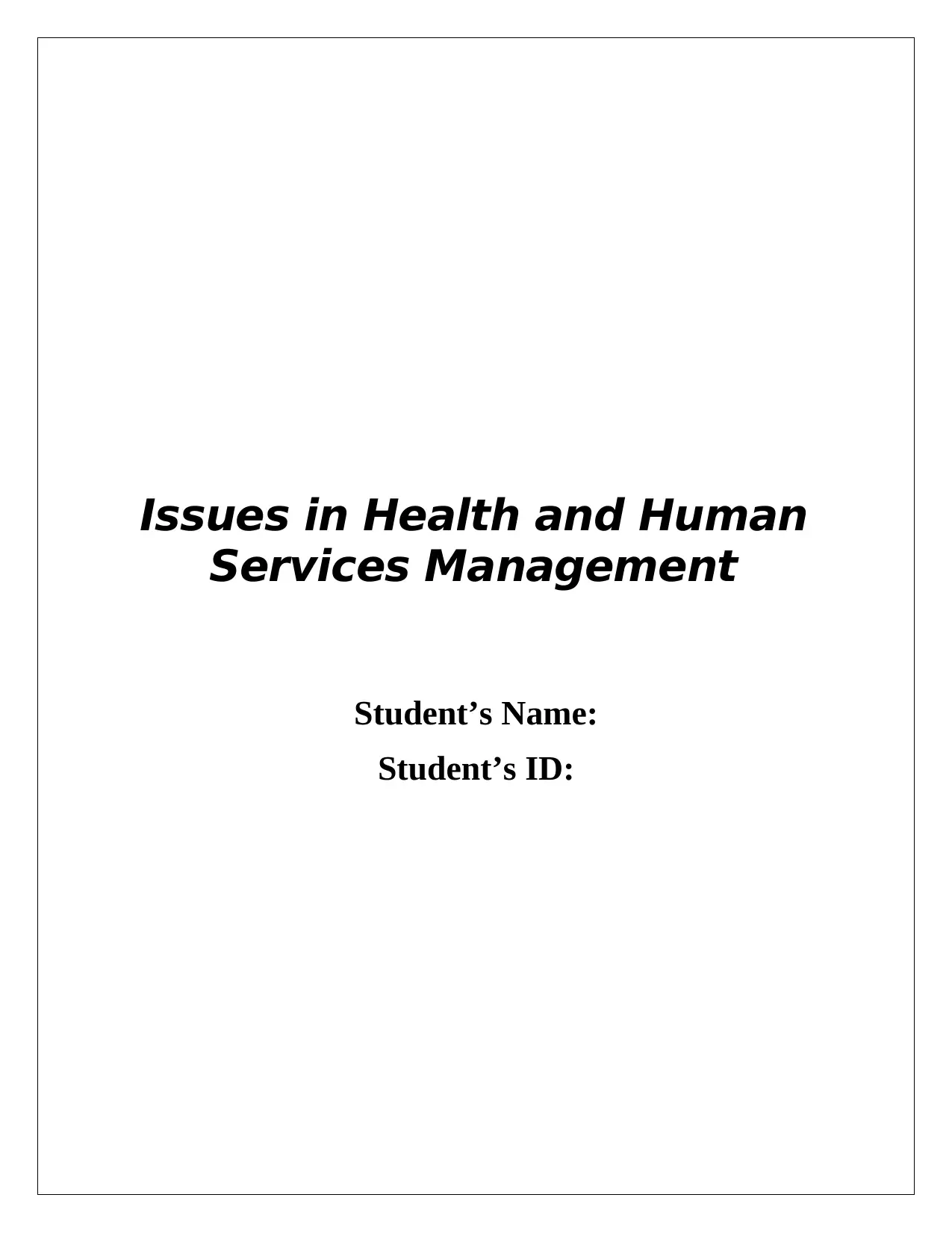
Issues in Health and Human
Services Management
Student’s Name:
Student’s ID:
Services Management
Student’s Name:
Student’s ID:
Secure Best Marks with AI Grader
Need help grading? Try our AI Grader for instant feedback on your assignments.
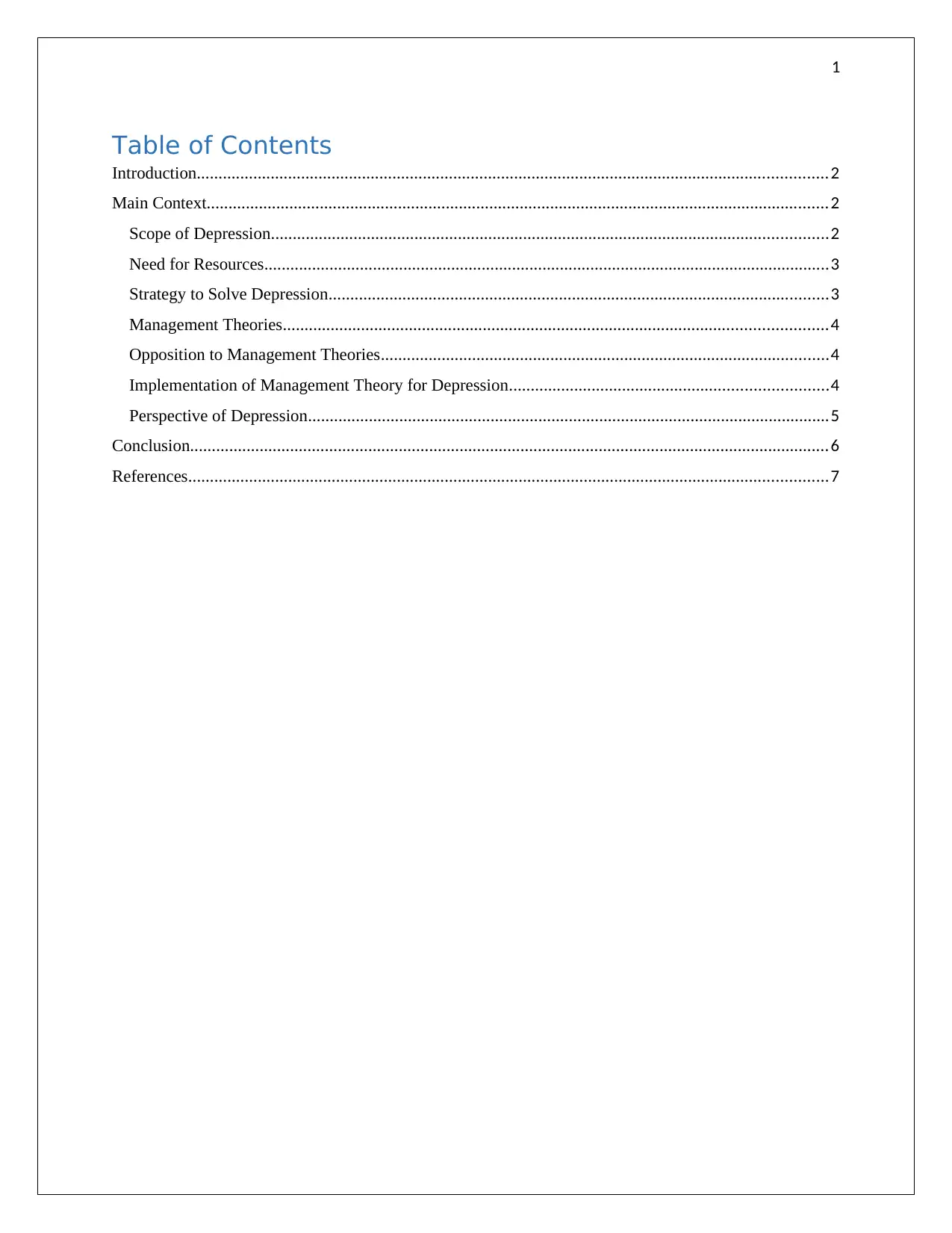
1
Table of Contents
Introduction.................................................................................................................................................2
Main Context...............................................................................................................................................2
Scope of Depression................................................................................................................................2
Need for Resources..................................................................................................................................3
Strategy to Solve Depression...................................................................................................................3
Management Theories.............................................................................................................................4
Opposition to Management Theories.......................................................................................................4
Implementation of Management Theory for Depression.........................................................................4
Perspective of Depression........................................................................................................................5
Conclusion...................................................................................................................................................6
References...................................................................................................................................................7
Table of Contents
Introduction.................................................................................................................................................2
Main Context...............................................................................................................................................2
Scope of Depression................................................................................................................................2
Need for Resources..................................................................................................................................3
Strategy to Solve Depression...................................................................................................................3
Management Theories.............................................................................................................................4
Opposition to Management Theories.......................................................................................................4
Implementation of Management Theory for Depression.........................................................................4
Perspective of Depression........................................................................................................................5
Conclusion...................................................................................................................................................6
References...................................................................................................................................................7
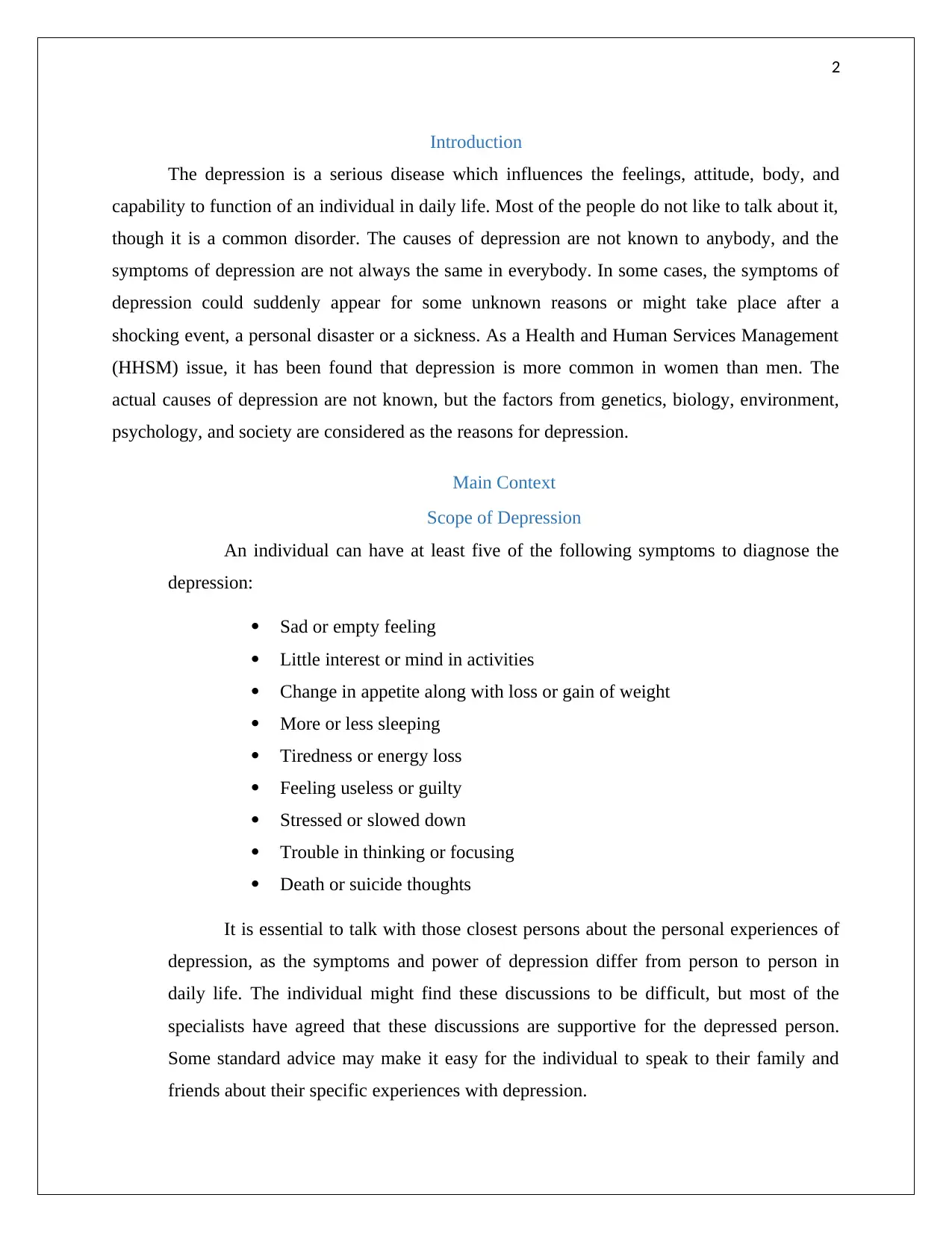
2
Introduction
The depression is a serious disease which influences the feelings, attitude, body, and
capability to function of an individual in daily life. Most of the people do not like to talk about it,
though it is a common disorder. The causes of depression are not known to anybody, and the
symptoms of depression are not always the same in everybody. In some cases, the symptoms of
depression could suddenly appear for some unknown reasons or might take place after a
shocking event, a personal disaster or a sickness. As a Health and Human Services Management
(HHSM) issue, it has been found that depression is more common in women than men. The
actual causes of depression are not known, but the factors from genetics, biology, environment,
psychology, and society are considered as the reasons for depression.
Main Context
Scope of Depression
An individual can have at least five of the following symptoms to diagnose the
depression:
Sad or empty feeling
Little interest or mind in activities
Change in appetite along with loss or gain of weight
More or less sleeping
Tiredness or energy loss
Feeling useless or guilty
Stressed or slowed down
Trouble in thinking or focusing
Death or suicide thoughts
It is essential to talk with those closest persons about the personal experiences of
depression, as the symptoms and power of depression differ from person to person in
daily life. The individual might find these discussions to be difficult, but most of the
specialists have agreed that these discussions are supportive for the depressed person.
Some standard advice may make it easy for the individual to speak to their family and
friends about their specific experiences with depression.
Introduction
The depression is a serious disease which influences the feelings, attitude, body, and
capability to function of an individual in daily life. Most of the people do not like to talk about it,
though it is a common disorder. The causes of depression are not known to anybody, and the
symptoms of depression are not always the same in everybody. In some cases, the symptoms of
depression could suddenly appear for some unknown reasons or might take place after a
shocking event, a personal disaster or a sickness. As a Health and Human Services Management
(HHSM) issue, it has been found that depression is more common in women than men. The
actual causes of depression are not known, but the factors from genetics, biology, environment,
psychology, and society are considered as the reasons for depression.
Main Context
Scope of Depression
An individual can have at least five of the following symptoms to diagnose the
depression:
Sad or empty feeling
Little interest or mind in activities
Change in appetite along with loss or gain of weight
More or less sleeping
Tiredness or energy loss
Feeling useless or guilty
Stressed or slowed down
Trouble in thinking or focusing
Death or suicide thoughts
It is essential to talk with those closest persons about the personal experiences of
depression, as the symptoms and power of depression differ from person to person in
daily life. The individual might find these discussions to be difficult, but most of the
specialists have agreed that these discussions are supportive for the depressed person.
Some standard advice may make it easy for the individual to speak to their family and
friends about their specific experiences with depression.
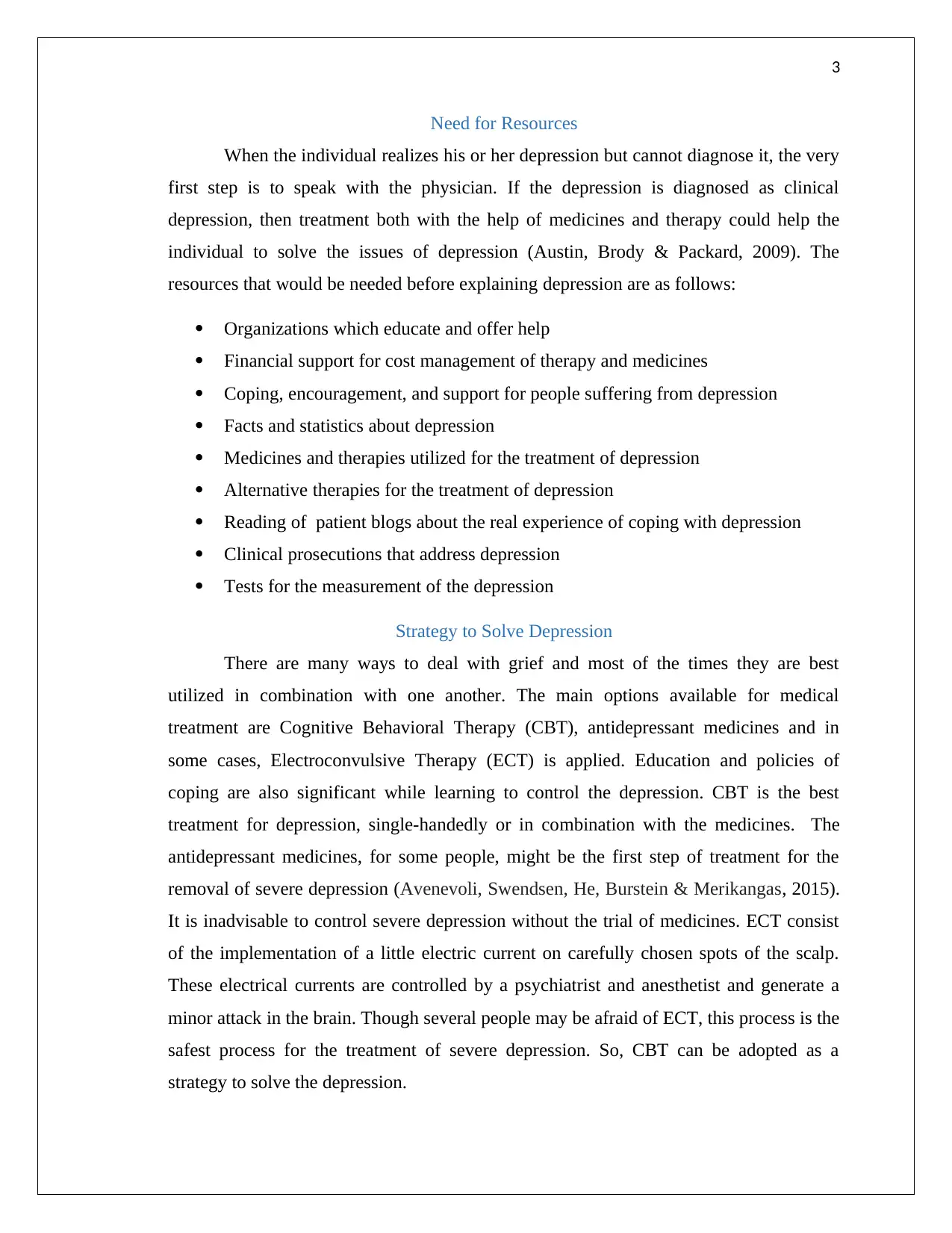
3
Need for Resources
When the individual realizes his or her depression but cannot diagnose it, the very
first step is to speak with the physician. If the depression is diagnosed as clinical
depression, then treatment both with the help of medicines and therapy could help the
individual to solve the issues of depression (Austin, Brody & Packard, 2009). The
resources that would be needed before explaining depression are as follows:
Organizations which educate and offer help
Financial support for cost management of therapy and medicines
Coping, encouragement, and support for people suffering from depression
Facts and statistics about depression
Medicines and therapies utilized for the treatment of depression
Alternative therapies for the treatment of depression
Reading of patient blogs about the real experience of coping with depression
Clinical prosecutions that address depression
Tests for the measurement of the depression
Strategy to Solve Depression
There are many ways to deal with grief and most of the times they are best
utilized in combination with one another. The main options available for medical
treatment are Cognitive Behavioral Therapy (CBT), antidepressant medicines and in
some cases, Electroconvulsive Therapy (ECT) is applied. Education and policies of
coping are also significant while learning to control the depression. CBT is the best
treatment for depression, single-handedly or in combination with the medicines. The
antidepressant medicines, for some people, might be the first step of treatment for the
removal of severe depression (Avenevoli, Swendsen, He, Burstein & Merikangas, 2015).
It is inadvisable to control severe depression without the trial of medicines. ECT consist
of the implementation of a little electric current on carefully chosen spots of the scalp.
These electrical currents are controlled by a psychiatrist and anesthetist and generate a
minor attack in the brain. Though several people may be afraid of ECT, this process is the
safest process for the treatment of severe depression. So, CBT can be adopted as a
strategy to solve the depression.
Need for Resources
When the individual realizes his or her depression but cannot diagnose it, the very
first step is to speak with the physician. If the depression is diagnosed as clinical
depression, then treatment both with the help of medicines and therapy could help the
individual to solve the issues of depression (Austin, Brody & Packard, 2009). The
resources that would be needed before explaining depression are as follows:
Organizations which educate and offer help
Financial support for cost management of therapy and medicines
Coping, encouragement, and support for people suffering from depression
Facts and statistics about depression
Medicines and therapies utilized for the treatment of depression
Alternative therapies for the treatment of depression
Reading of patient blogs about the real experience of coping with depression
Clinical prosecutions that address depression
Tests for the measurement of the depression
Strategy to Solve Depression
There are many ways to deal with grief and most of the times they are best
utilized in combination with one another. The main options available for medical
treatment are Cognitive Behavioral Therapy (CBT), antidepressant medicines and in
some cases, Electroconvulsive Therapy (ECT) is applied. Education and policies of
coping are also significant while learning to control the depression. CBT is the best
treatment for depression, single-handedly or in combination with the medicines. The
antidepressant medicines, for some people, might be the first step of treatment for the
removal of severe depression (Avenevoli, Swendsen, He, Burstein & Merikangas, 2015).
It is inadvisable to control severe depression without the trial of medicines. ECT consist
of the implementation of a little electric current on carefully chosen spots of the scalp.
These electrical currents are controlled by a psychiatrist and anesthetist and generate a
minor attack in the brain. Though several people may be afraid of ECT, this process is the
safest process for the treatment of severe depression. So, CBT can be adopted as a
strategy to solve the depression.
Secure Best Marks with AI Grader
Need help grading? Try our AI Grader for instant feedback on your assignments.
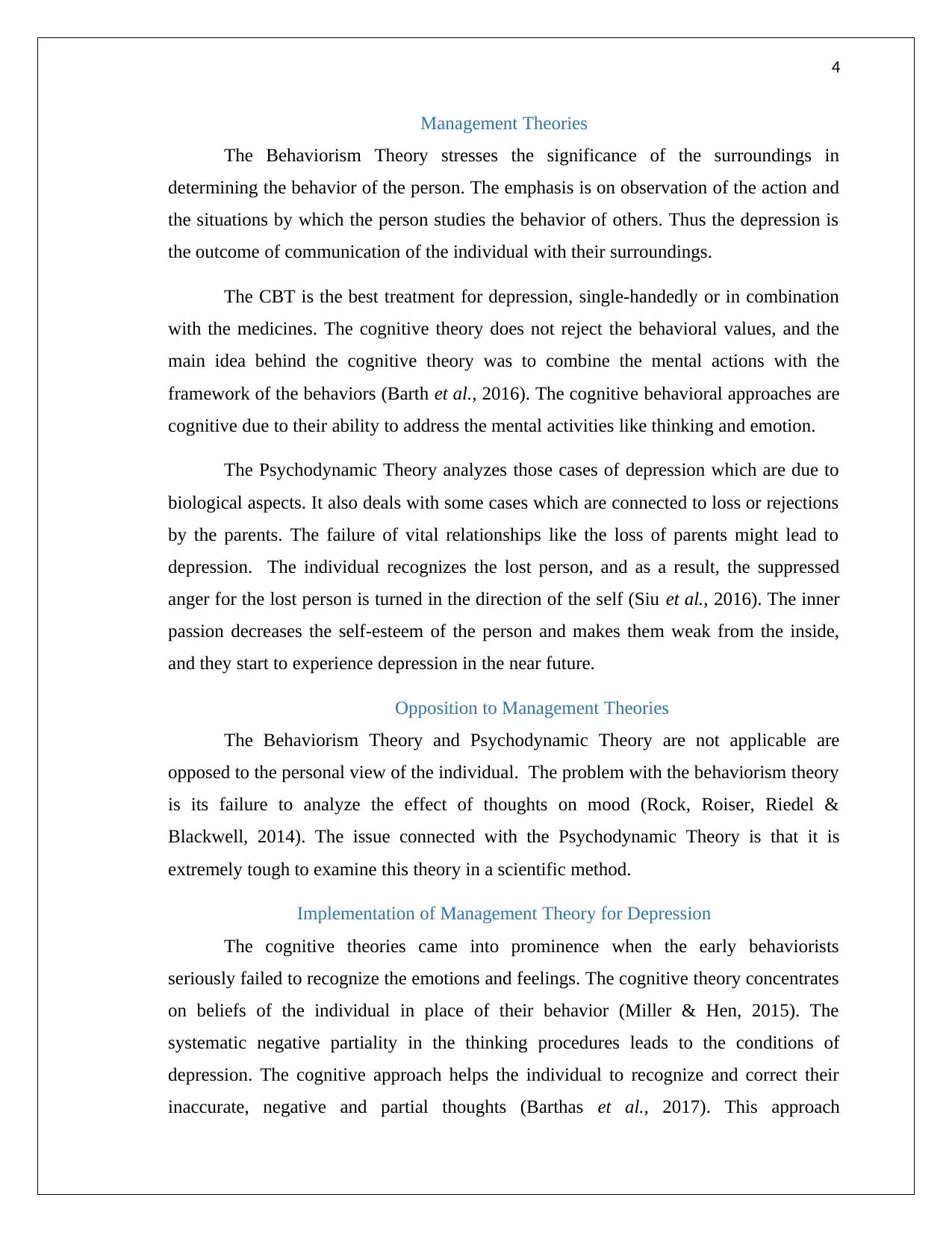
4
Management Theories
The Behaviorism Theory stresses the significance of the surroundings in
determining the behavior of the person. The emphasis is on observation of the action and
the situations by which the person studies the behavior of others. Thus the depression is
the outcome of communication of the individual with their surroundings.
The CBT is the best treatment for depression, single-handedly or in combination
with the medicines. The cognitive theory does not reject the behavioral values, and the
main idea behind the cognitive theory was to combine the mental actions with the
framework of the behaviors (Barth et al., 2016). The cognitive behavioral approaches are
cognitive due to their ability to address the mental activities like thinking and emotion.
The Psychodynamic Theory analyzes those cases of depression which are due to
biological aspects. It also deals with some cases which are connected to loss or rejections
by the parents. The failure of vital relationships like the loss of parents might lead to
depression. The individual recognizes the lost person, and as a result, the suppressed
anger for the lost person is turned in the direction of the self (Siu et al., 2016). The inner
passion decreases the self-esteem of the person and makes them weak from the inside,
and they start to experience depression in the near future.
Opposition to Management Theories
The Behaviorism Theory and Psychodynamic Theory are not applicable are
opposed to the personal view of the individual. The problem with the behaviorism theory
is its failure to analyze the effect of thoughts on mood (Rock, Roiser, Riedel &
Blackwell, 2014). The issue connected with the Psychodynamic Theory is that it is
extremely tough to examine this theory in a scientific method.
Implementation of Management Theory for Depression
The cognitive theories came into prominence when the early behaviorists
seriously failed to recognize the emotions and feelings. The cognitive theory concentrates
on beliefs of the individual in place of their behavior (Miller & Hen, 2015). The
systematic negative partiality in the thinking procedures leads to the conditions of
depression. The cognitive approach helps the individual to recognize and correct their
inaccurate, negative and partial thoughts (Barthas et al., 2017). This approach
Management Theories
The Behaviorism Theory stresses the significance of the surroundings in
determining the behavior of the person. The emphasis is on observation of the action and
the situations by which the person studies the behavior of others. Thus the depression is
the outcome of communication of the individual with their surroundings.
The CBT is the best treatment for depression, single-handedly or in combination
with the medicines. The cognitive theory does not reject the behavioral values, and the
main idea behind the cognitive theory was to combine the mental actions with the
framework of the behaviors (Barth et al., 2016). The cognitive behavioral approaches are
cognitive due to their ability to address the mental activities like thinking and emotion.
The Psychodynamic Theory analyzes those cases of depression which are due to
biological aspects. It also deals with some cases which are connected to loss or rejections
by the parents. The failure of vital relationships like the loss of parents might lead to
depression. The individual recognizes the lost person, and as a result, the suppressed
anger for the lost person is turned in the direction of the self (Siu et al., 2016). The inner
passion decreases the self-esteem of the person and makes them weak from the inside,
and they start to experience depression in the near future.
Opposition to Management Theories
The Behaviorism Theory and Psychodynamic Theory are not applicable are
opposed to the personal view of the individual. The problem with the behaviorism theory
is its failure to analyze the effect of thoughts on mood (Rock, Roiser, Riedel &
Blackwell, 2014). The issue connected with the Psychodynamic Theory is that it is
extremely tough to examine this theory in a scientific method.
Implementation of Management Theory for Depression
The cognitive theories came into prominence when the early behaviorists
seriously failed to recognize the emotions and feelings. The cognitive theory concentrates
on beliefs of the individual in place of their behavior (Miller & Hen, 2015). The
systematic negative partiality in the thinking procedures leads to the conditions of
depression. The cognitive approach helps the individual to recognize and correct their
inaccurate, negative and partial thoughts (Barthas et al., 2017). This approach
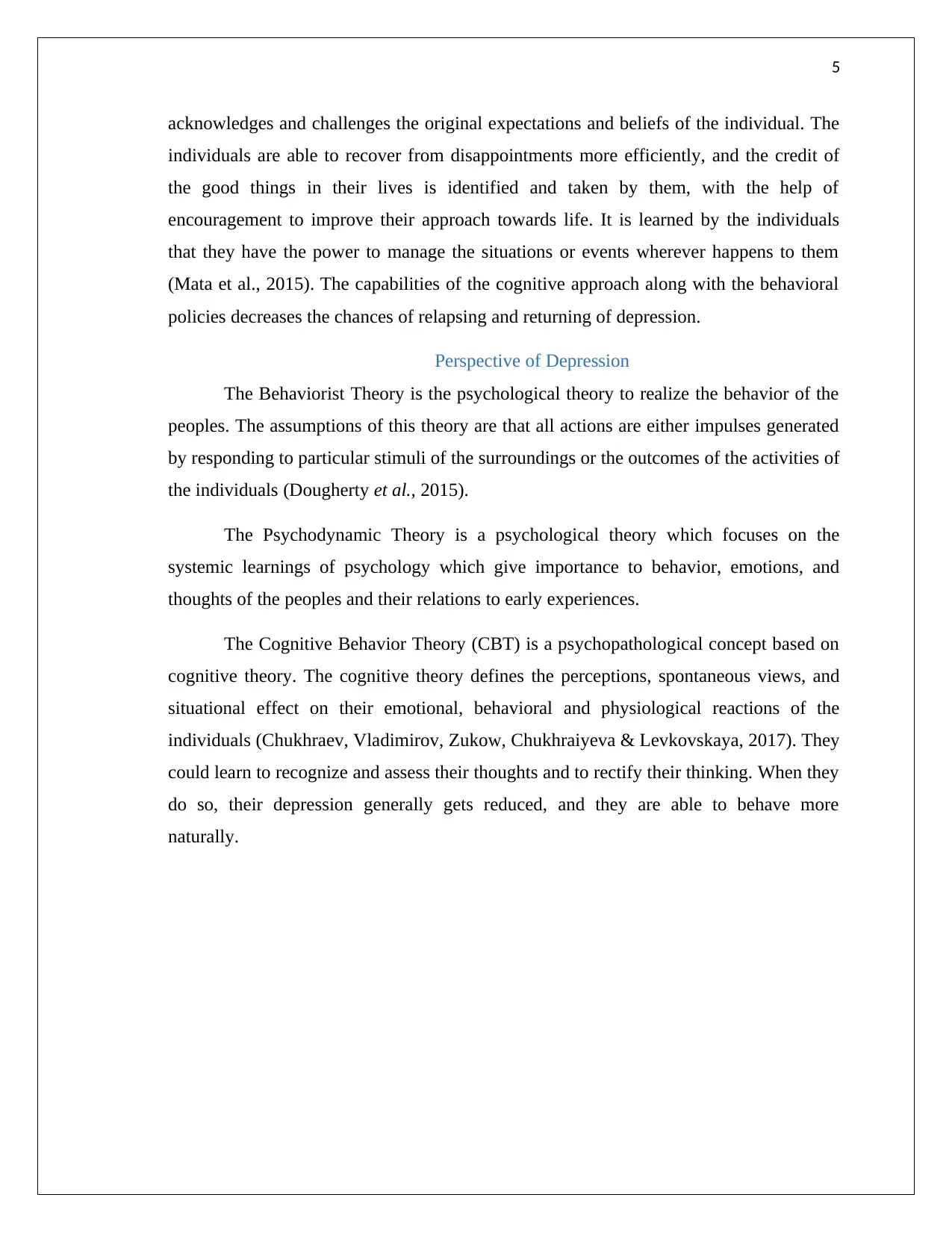
5
acknowledges and challenges the original expectations and beliefs of the individual. The
individuals are able to recover from disappointments more efficiently, and the credit of
the good things in their lives is identified and taken by them, with the help of
encouragement to improve their approach towards life. It is learned by the individuals
that they have the power to manage the situations or events wherever happens to them
(Mata et al., 2015). The capabilities of the cognitive approach along with the behavioral
policies decreases the chances of relapsing and returning of depression.
Perspective of Depression
The Behaviorist Theory is the psychological theory to realize the behavior of the
peoples. The assumptions of this theory are that all actions are either impulses generated
by responding to particular stimuli of the surroundings or the outcomes of the activities of
the individuals (Dougherty et al., 2015).
The Psychodynamic Theory is a psychological theory which focuses on the
systemic learnings of psychology which give importance to behavior, emotions, and
thoughts of the peoples and their relations to early experiences.
The Cognitive Behavior Theory (CBT) is a psychopathological concept based on
cognitive theory. The cognitive theory defines the perceptions, spontaneous views, and
situational effect on their emotional, behavioral and physiological reactions of the
individuals (Chukhraev, Vladimirov, Zukow, Chukhraiyeva & Levkovskaya, 2017). They
could learn to recognize and assess their thoughts and to rectify their thinking. When they
do so, their depression generally gets reduced, and they are able to behave more
naturally.
acknowledges and challenges the original expectations and beliefs of the individual. The
individuals are able to recover from disappointments more efficiently, and the credit of
the good things in their lives is identified and taken by them, with the help of
encouragement to improve their approach towards life. It is learned by the individuals
that they have the power to manage the situations or events wherever happens to them
(Mata et al., 2015). The capabilities of the cognitive approach along with the behavioral
policies decreases the chances of relapsing and returning of depression.
Perspective of Depression
The Behaviorist Theory is the psychological theory to realize the behavior of the
peoples. The assumptions of this theory are that all actions are either impulses generated
by responding to particular stimuli of the surroundings or the outcomes of the activities of
the individuals (Dougherty et al., 2015).
The Psychodynamic Theory is a psychological theory which focuses on the
systemic learnings of psychology which give importance to behavior, emotions, and
thoughts of the peoples and their relations to early experiences.
The Cognitive Behavior Theory (CBT) is a psychopathological concept based on
cognitive theory. The cognitive theory defines the perceptions, spontaneous views, and
situational effect on their emotional, behavioral and physiological reactions of the
individuals (Chukhraev, Vladimirov, Zukow, Chukhraiyeva & Levkovskaya, 2017). They
could learn to recognize and assess their thoughts and to rectify their thinking. When they
do so, their depression generally gets reduced, and they are able to behave more
naturally.
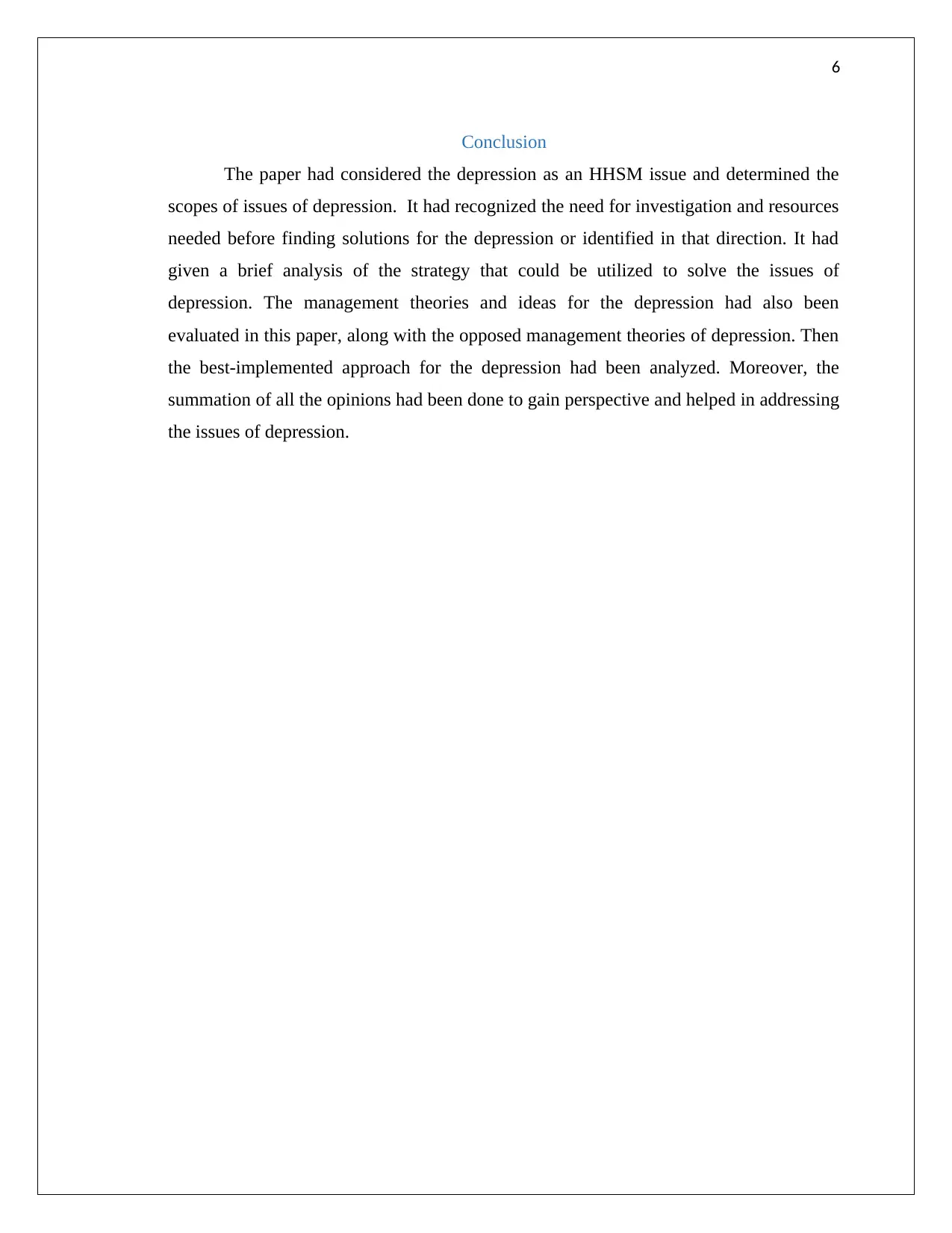
6
Conclusion
The paper had considered the depression as an HHSM issue and determined the
scopes of issues of depression. It had recognized the need for investigation and resources
needed before finding solutions for the depression or identified in that direction. It had
given a brief analysis of the strategy that could be utilized to solve the issues of
depression. The management theories and ideas for the depression had also been
evaluated in this paper, along with the opposed management theories of depression. Then
the best-implemented approach for the depression had been analyzed. Moreover, the
summation of all the opinions had been done to gain perspective and helped in addressing
the issues of depression.
Conclusion
The paper had considered the depression as an HHSM issue and determined the
scopes of issues of depression. It had recognized the need for investigation and resources
needed before finding solutions for the depression or identified in that direction. It had
given a brief analysis of the strategy that could be utilized to solve the issues of
depression. The management theories and ideas for the depression had also been
evaluated in this paper, along with the opposed management theories of depression. Then
the best-implemented approach for the depression had been analyzed. Moreover, the
summation of all the opinions had been done to gain perspective and helped in addressing
the issues of depression.
Paraphrase This Document
Need a fresh take? Get an instant paraphrase of this document with our AI Paraphraser
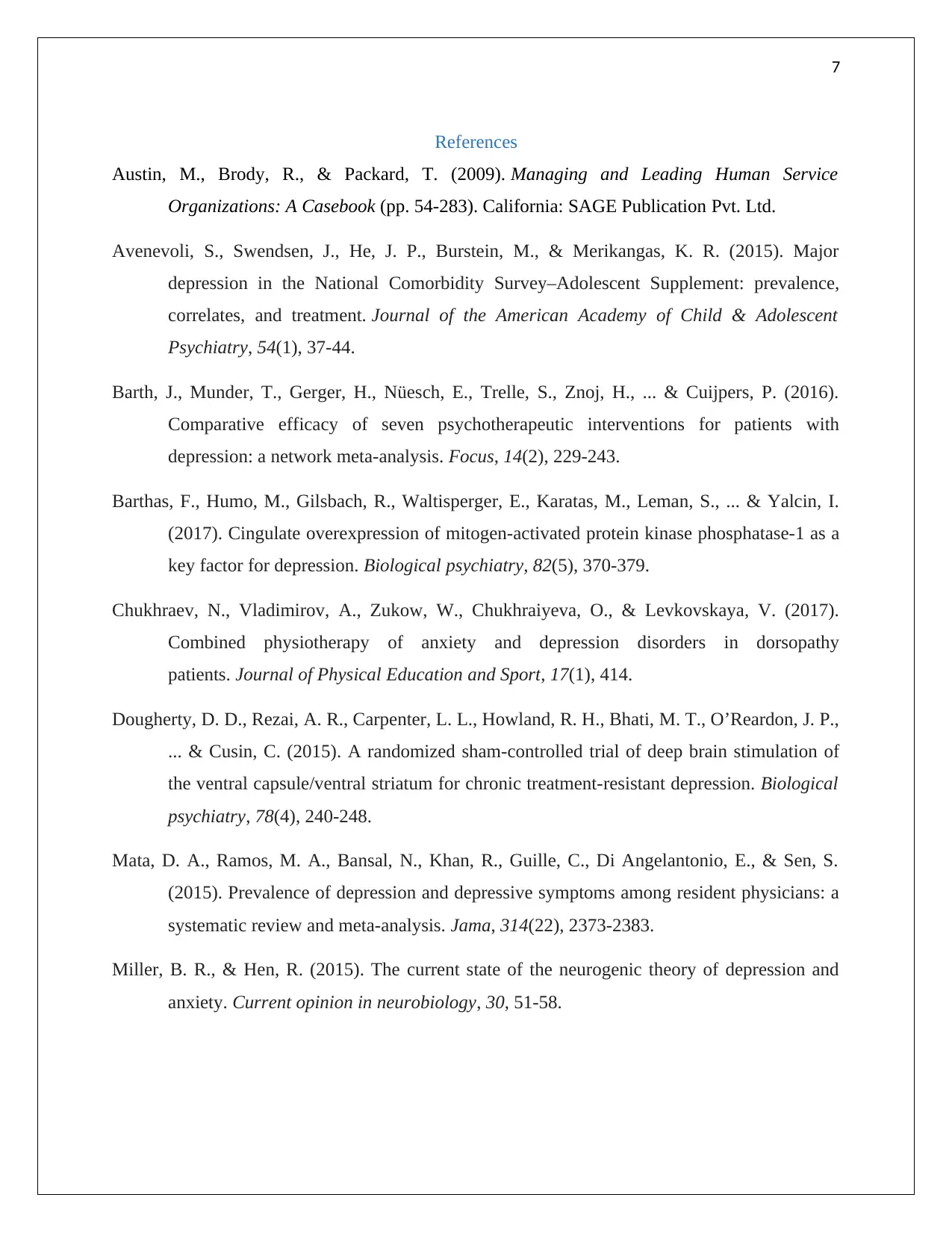
7
References
Austin, M., Brody, R., & Packard, T. (2009). Managing and Leading Human Service
Organizations: A Casebook (pp. 54-283). California: SAGE Publication Pvt. Ltd.
Avenevoli, S., Swendsen, J., He, J. P., Burstein, M., & Merikangas, K. R. (2015). Major
depression in the National Comorbidity Survey–Adolescent Supplement: prevalence,
correlates, and treatment. Journal of the American Academy of Child & Adolescent
Psychiatry, 54(1), 37-44.
Barth, J., Munder, T., Gerger, H., Nüesch, E., Trelle, S., Znoj, H., ... & Cuijpers, P. (2016).
Comparative efficacy of seven psychotherapeutic interventions for patients with
depression: a network meta-analysis. Focus, 14(2), 229-243.
Barthas, F., Humo, M., Gilsbach, R., Waltisperger, E., Karatas, M., Leman, S., ... & Yalcin, I.
(2017). Cingulate overexpression of mitogen-activated protein kinase phosphatase-1 as a
key factor for depression. Biological psychiatry, 82(5), 370-379.
Chukhraev, N., Vladimirov, A., Zukow, W., Chukhraiyeva, O., & Levkovskaya, V. (2017).
Combined physiotherapy of anxiety and depression disorders in dorsopathy
patients. Journal of Physical Education and Sport, 17(1), 414.
Dougherty, D. D., Rezai, A. R., Carpenter, L. L., Howland, R. H., Bhati, M. T., O’Reardon, J. P.,
... & Cusin, C. (2015). A randomized sham-controlled trial of deep brain stimulation of
the ventral capsule/ventral striatum for chronic treatment-resistant depression. Biological
psychiatry, 78(4), 240-248.
Mata, D. A., Ramos, M. A., Bansal, N., Khan, R., Guille, C., Di Angelantonio, E., & Sen, S.
(2015). Prevalence of depression and depressive symptoms among resident physicians: a
systematic review and meta-analysis. Jama, 314(22), 2373-2383.
Miller, B. R., & Hen, R. (2015). The current state of the neurogenic theory of depression and
anxiety. Current opinion in neurobiology, 30, 51-58.
References
Austin, M., Brody, R., & Packard, T. (2009). Managing and Leading Human Service
Organizations: A Casebook (pp. 54-283). California: SAGE Publication Pvt. Ltd.
Avenevoli, S., Swendsen, J., He, J. P., Burstein, M., & Merikangas, K. R. (2015). Major
depression in the National Comorbidity Survey–Adolescent Supplement: prevalence,
correlates, and treatment. Journal of the American Academy of Child & Adolescent
Psychiatry, 54(1), 37-44.
Barth, J., Munder, T., Gerger, H., Nüesch, E., Trelle, S., Znoj, H., ... & Cuijpers, P. (2016).
Comparative efficacy of seven psychotherapeutic interventions for patients with
depression: a network meta-analysis. Focus, 14(2), 229-243.
Barthas, F., Humo, M., Gilsbach, R., Waltisperger, E., Karatas, M., Leman, S., ... & Yalcin, I.
(2017). Cingulate overexpression of mitogen-activated protein kinase phosphatase-1 as a
key factor for depression. Biological psychiatry, 82(5), 370-379.
Chukhraev, N., Vladimirov, A., Zukow, W., Chukhraiyeva, O., & Levkovskaya, V. (2017).
Combined physiotherapy of anxiety and depression disorders in dorsopathy
patients. Journal of Physical Education and Sport, 17(1), 414.
Dougherty, D. D., Rezai, A. R., Carpenter, L. L., Howland, R. H., Bhati, M. T., O’Reardon, J. P.,
... & Cusin, C. (2015). A randomized sham-controlled trial of deep brain stimulation of
the ventral capsule/ventral striatum for chronic treatment-resistant depression. Biological
psychiatry, 78(4), 240-248.
Mata, D. A., Ramos, M. A., Bansal, N., Khan, R., Guille, C., Di Angelantonio, E., & Sen, S.
(2015). Prevalence of depression and depressive symptoms among resident physicians: a
systematic review and meta-analysis. Jama, 314(22), 2373-2383.
Miller, B. R., & Hen, R. (2015). The current state of the neurogenic theory of depression and
anxiety. Current opinion in neurobiology, 30, 51-58.
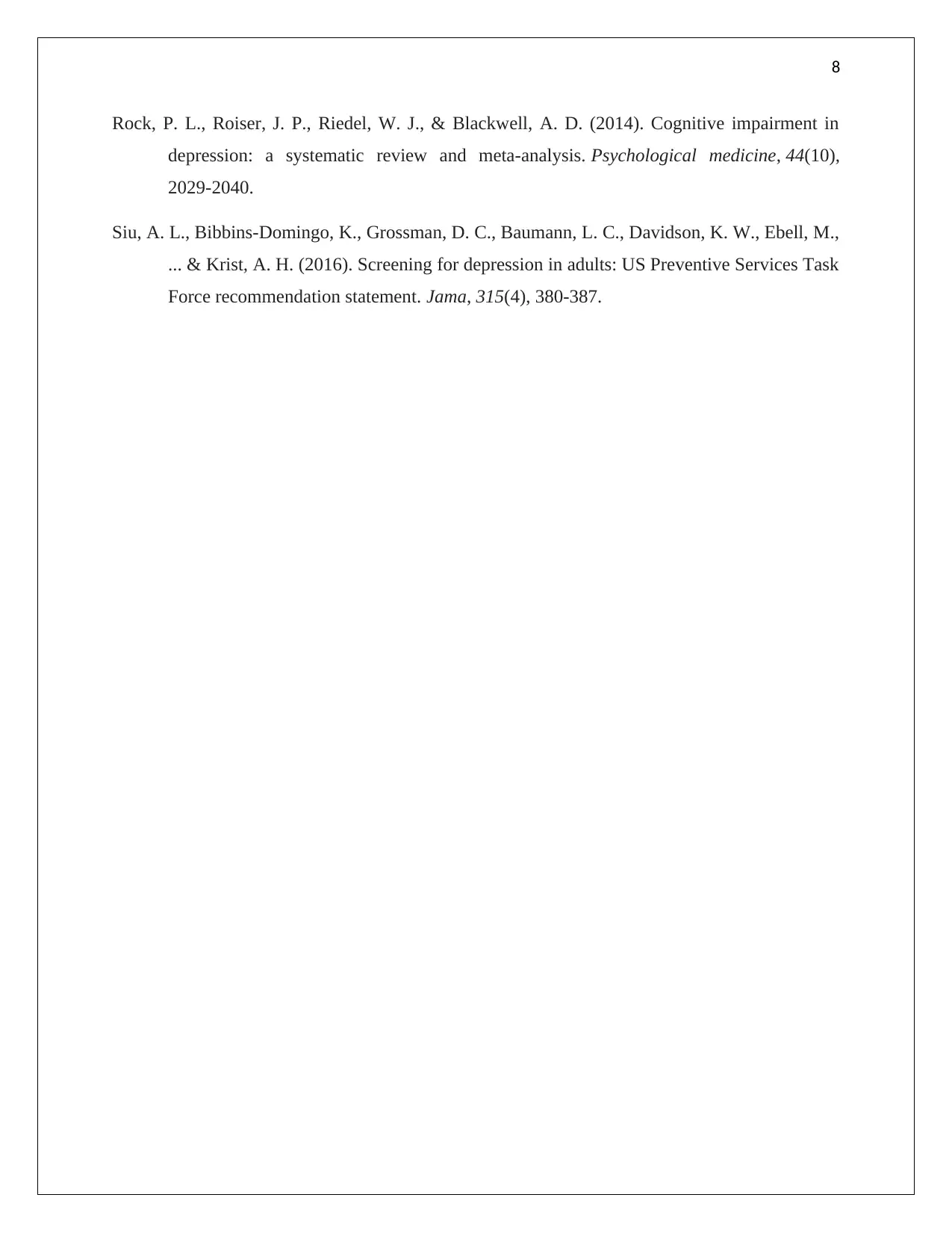
8
Rock, P. L., Roiser, J. P., Riedel, W. J., & Blackwell, A. D. (2014). Cognitive impairment in
depression: a systematic review and meta-analysis. Psychological medicine, 44(10),
2029-2040.
Siu, A. L., Bibbins-Domingo, K., Grossman, D. C., Baumann, L. C., Davidson, K. W., Ebell, M.,
... & Krist, A. H. (2016). Screening for depression in adults: US Preventive Services Task
Force recommendation statement. Jama, 315(4), 380-387.
Rock, P. L., Roiser, J. P., Riedel, W. J., & Blackwell, A. D. (2014). Cognitive impairment in
depression: a systematic review and meta-analysis. Psychological medicine, 44(10),
2029-2040.
Siu, A. L., Bibbins-Domingo, K., Grossman, D. C., Baumann, L. C., Davidson, K. W., Ebell, M.,
... & Krist, A. H. (2016). Screening for depression in adults: US Preventive Services Task
Force recommendation statement. Jama, 315(4), 380-387.
1 out of 9
Related Documents
Your All-in-One AI-Powered Toolkit for Academic Success.
+13062052269
info@desklib.com
Available 24*7 on WhatsApp / Email
![[object Object]](/_next/static/media/star-bottom.7253800d.svg)
Unlock your academic potential
© 2024 | Zucol Services PVT LTD | All rights reserved.




